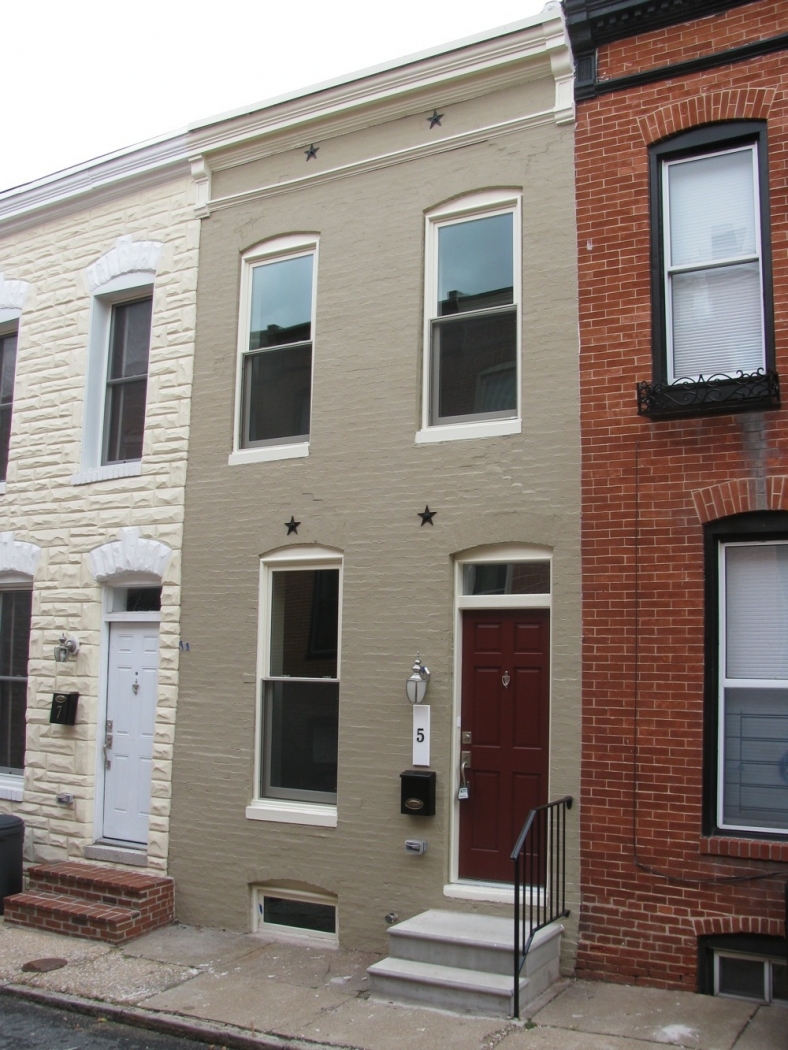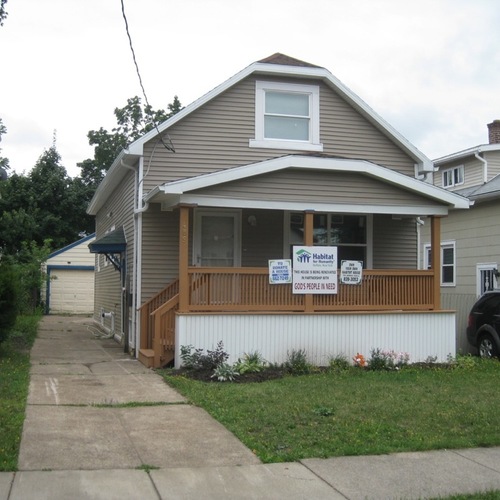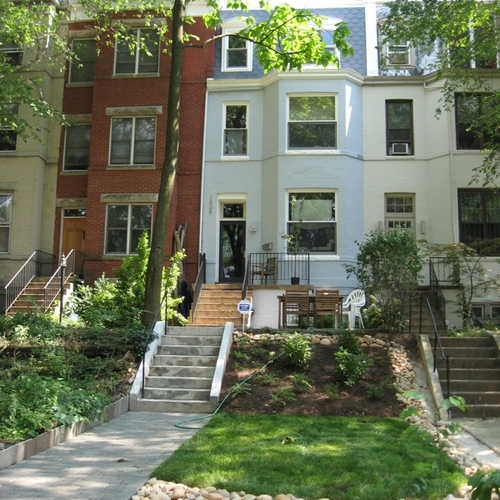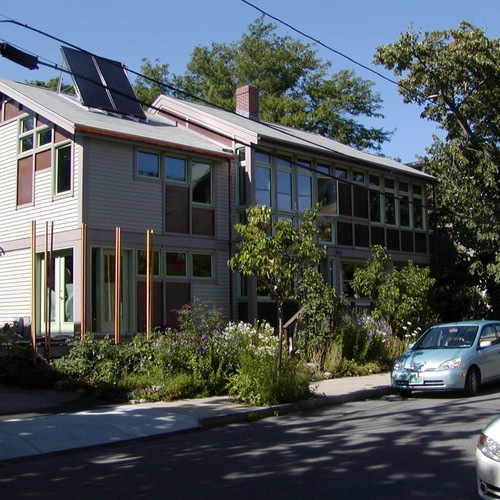
Image Credit: TerraLogos
Image Credit: TerraLogos View of the existing 1st floor interior with the boxed in area comprising the entry vestibule and coat closet.
Image Credit: TerraLogos View from the original living room looking into the kitchen at the rear of the home.
Image Credit: TerraLogos The completed 1st floor looking from the living space into the new galley kitchen.
Image Credit: TerraLogos The new kitchen with the focal point sink island. All of the kitchen appliances are Energy Star and faucet is EPA WaterSense.
Image Credit: TerraLogos A common design feature of TerraLogos' work on these Baltimore rowhomes is the replacement of failing skylights with light monitor wells that are detailed for long term water management and provide better indirect and diffuse light than skylights.
Image Credit: TerraLogos The renovated basement with new concrete slab and mechanicals. You can't see the insulation and air-sealing measures in the rim joist area.
Image Credit: TerraLogos A typical rowhome backyard, paved to discourage pests but with potted seasonal greenery.
Image Credit: TerraLogos Rooftop view of a Baltimore sunset from 135 Decker.
Image Credit: TerraLogos Floor plan of basement.
Image Credit: TerraLogos Floor plan first floor.
Image Credit: TerraLogos Floor plan reconfigured 2nd floor.
Image Credit: TerraLogos Set of drawings for a TerraLogos rowhome project very similar to 135 N Decker.
Image Credit: TerraLogos One-page summary of another TerraLogos project on a Baltimore rowhome.
Image Credit: TerraLogos
Working with Habitat for Humanity of the Chesapeake, green architectural firm TerraLogos develops a streamlined design and permit set process for 50 Baltimore rowhomes
At just around 1,000 square feet, existing rowhomes in Baltimore represent a true design challenge. Of course, any redesign or retrofit should be green and affordable.
Streamlining assessment, design, and permitting
“When you get a call to move 50 abandoned and/or foreclosed homes to occupancy in less than two years, you are both thankful and a little taken aback,” says Kim Schaefer, owner of TerraLogos: eco architecture. “To process dozens of homes on a compressed schedule, we made sure to listen to our client. From those conversations we created a process to deliver energy-efficient, healthy and affordable homes on time and within budget while promoting efficient construction of the rehabs.”
TerraLogos also developed four levels of renovation packages — from cosmetic through gut rehab — and provided custom design services for structures with special requirements such as ADA accessibility or five bedrooms (in a two-story row home!).
The TerraLogos Green Rowhouse Renovation Template
A key element of this process was using the TerraLogos Green Rowhouse Renovation Template©. Kim shares, “We improved our template, customizing each template plan for the existing conditions and designed the heating and cooling system for each home. After getting the initial call in October, 2010, we started design full-bore in December, and cranked out 22 house plans with full permit sets by February.”
Developed over the last 8 years, the TL Green Rowhouse Renovation Template© is a standardized permit plan set for the rehabilitation of typical, two or three story brick attached townhomes. The template includes a uniform site survey, existing conditions base plans, and designs that incorporate green building technology and advanced energy efficiency strategies. The Template was created for use by developers doing multiple renovations allowing for quality design and architectural services on a sliding fee scale.
Healthy Neighborhoods
Habitat for Humanity of the Chesapeake (HFHC) is working through Healthy Neighborhoods under a federal Neighborhood Stabilization Program 2 (NSP2) HUD grant in both East Baltimore’s Patterson Park and McElderry Park neighborhoods. The Patterson Park neighborhood is adjacent to one of the oldest parks in Baltimore and McElderry Park is a neighborhood experiencing revival just east of the Johns Hopkins Medical Center.
Jen Wassmann is the site supervisor for HFHC. When I asked her about TerraLogos and their work on greening affordable housing in partnership with HFHC, here is what she had to say: “We have received great guidance and advice on energy savings and maintaining affordability from TerraLogos. But one of the stand-out aspects of our work with TerraLogos is that they are local; they live and work in the greater local Baltimore community and they are highly invested in our work on green affordable housing.”
135 North Decker
Originally built in 1912, this rowhome had (luckily) only been victim to a few failing DIY “improvements” by past owners. Utilizing the NSP2 grant money, HFHC purchased this foreclosed home and TerraLogos got to work on assessing its current condition.
Water leakage from the original skylight had damaged some of the existing ceilings, so TerraLogos designed a light monitor which floods the hallway with natural light to replace the leaking skylight. At 11’3” wide, this rowhome needed to make the most of every inch, so the kitchen was designed galley-style, with the sink located in a central island.
An open first-floor plan allows the living room, dining room and kitchen to flow together. Without walls and separation, light streams in from the opposing ends of the house during the day.
Two bedrooms fit on the second floor, one on each end of the house, providing expansive views and daylighting. The bathroom and laundry closet are nestled into the second-floor hallway. Both are equipped with low-flow fixtures.
The original floor plan wasted much of the second floor space, but by reorienting the bathroom along the length of the hallway, the design created more spacious bedrooms and added standard closet space.
The rear yard has potential, but is very small. Generally this type of rowhome yard is paved with concrete to curtail rat problems. HFHC installs new wood privacy fences and gates for access to the rear alley for trash, recycling, and service access. TerraLogos promotes container gardens, trash bin storage, and small outdoor play or eating areas for the backyard design.
Homeowners in these neighborhoods have access to the Baltimore Blue Alley project and to alley gating programs which secure the alleys for shared open space and green plantings.
Weekly Newsletter
Get building science and energy efficiency advice, plus special offers, in your inbox.
Lessons Learned
TerraLogos works continuously with both HFHC’s construction management and family services staff to better meet the needs of the structure and the occupants. Kim adds, “We need to provide better documentation on basement air sealing for the construction team and the families are pushing for 3+ bedroom designs.”
Another learning experience arose from efforts to address basement ceiling height. The basements in most of these homes are almost always really shy on the height side. HFHC started, as many developers of these rowhomes do, digging out the basements by hand to create more head room or a living space in the basement. "This has proved really expensive, and so now we pretty much leave the basements at their existing height. We do add a concrete slab and seal and insulate the rim joists to complete the high performance envelope. The basement space is used for just mechanicals and often laundry," relates Kim Schaefer.
TerraLogos staff has also learned a lot by participating in the Women’s Build Project at 2412 Fairmount Ave., putting into practice the very designs and specifications they developed. This home will be completed and occupied by this Christmas.
General Specs and Team
| Location: | Baltimore, MD |
|---|---|
| Bedrooms: | 2 |
| Bathrooms: | 1 |
| Living Space: | 900 |
| Cost: | 88 |
| Additional Notes: | This cost includes the preferential pricing and product donations to which Habitat for Humanity projects have access. On this particular project (135 N. Decker), the volunteer labor associated with most HFH projects was not possible. |
Architect: TerraLogos: ecoarchitecture Builder: The Michael Group Building Partner: Habitat for Humanity of the Chesapeake
Construction
Foundation: Brick with concrete floor
Above-grade walls: Masonry with furred out 2x4s
Roof: Wood-framed low-slope with parapet
Energy
Windows: Trimline Liberty Series wood windows with low-e argon (U = 0.29)
Insulation: Blown-in cellulose
Air sealing: Closed-cell spray foam
Appliances: Whirlpool Energy Star kitchen appliances
Water Efficiency
Toilet: American Standard Cadet 3 FloWise
Kitchen & Lav Faucets: Delta Innovations WaterSense faucet











2 Comments
not helpful. More of a marketing description.
What about some details
This is a nine year old blog.
Log in or create an account to post a comment.
Sign up Log in